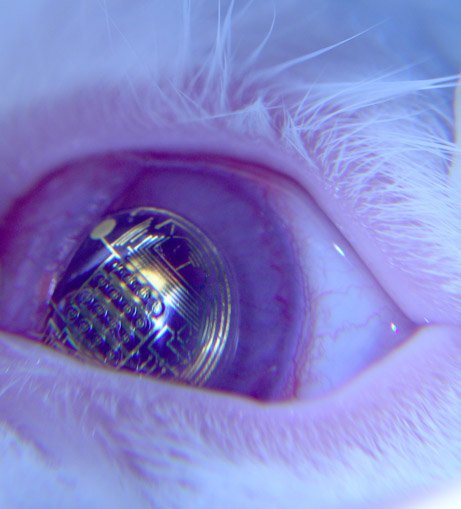Allen Zderad from Minnesota is now able to see his wife again after ten years of being blind due to a bionic eye.
The 68-year-old man started having serious vision problems around 20 years ago due to a condition known as retinitis pigmentosa, a degenerative eye disease which affects the retina.
Allen Zderad, who worked as a chemist when, was declared effectively blind a decade ago.
The man continued his hobby of woodwork by developing his sense of touch and spatial relationships.
Mayo Clinic researcher and ophthalmologist Dr. Raymond Iezzi Jr. had been working on the Second Sight Argus II retinal prosthesis system when he reached out to Allen Zderad.
Dr. Raymond Iezzi Jr. considered Allen Zderad a suitable candidate for a bionic implant.
During the process, the ophthalmologist fitted 60 electrodes into Allen Zderad’s eye.
The electrodes work by interacting with a special camera attached to the patient’s glasses and a separate computer pack capable of sending information to the electrodes embedded in Allen Zderad’s retina, which then sends signals straight to the optic nerve.
After implant, Allen Zderad, a grandfather of ten, explains that he can’t make out detail, but he can now make out shapes and outlines.
[youtube b1_efoktiAg 650]
Last month, the Food Drug Administration (FDA) was supposed to approve the Argus II Retinal Prosthesis System by California developer Second Sight, now those in the U.S. who would qualify for the device wait with bated breath as February roars on.
A first of its kind technology, first bionic eye Argus II was already approved for use in Europe in 2011 and is the culmination of 20 years of scientific research into the delicate and deeply complex sight organ.
The implant and eyewear duo will most benefit patients with an inherited form of degenerative blindness that destroys the retina called retinitis pigmentosa, which affects about 3,000 people in the U.S.
Sufferers of the disease experience a gradual retinal generation and an accompanying loss of vision that eventually leads to blindness.
By implanting a series of electrodes inside the eye, the Argus II prosthesis will make up for the failing retina by itself transmitting information about lightness and darkness, for instance, to the brain.
A second aspect of the Argus II is the eyeglass headset.
Patients wear eyeglasses mounted with cameras that then transmit data about what is in front of them to a small wearable computer.
From there, the information is transmitted wirelessly to the implant and the brain is sent a series of electrical impulses the patient eventually learns to interpret as light, dark, and shapes.
“No one really thought it would be possible because the tissue around the eye is so soft and delicate,” Dr. Mark Humayun, of the Keck School of Medicine at USC told the Wall Street Journal.
“If we continue to develop this type of technology and begin to understand the new electrical language of pulses to the brain, to the eye, we can apply it to other parts of the body and we can change our world and how we relate to it,” continued Dr. Mark Humayun, who has been working on the technology for 25 years and is co-creator the Argus II.

A first of its kind technology, first bionic eye Argus II was already approved for use in Europe in 2011 and is the culmination of 20 years of scientific research into the delicate and deeply complex sight organ
One early patient, Elias Konstantopoulos of Glen Burnie, Maryland, had lost his sight completely to retinitis pigmentosa and sought help from the Argus II researchers.
After undergoing the implantation in 2011, Elias Konstantopoulos was able to distinguish between dark and light and used that ability to help him maneuver through space.
His hope is to one day see the face of his grandson, Anthony.
Neither Elias Konstantopoulos nor any of the other recipients of the Argus II in the U.S. and Europe thus far are able to see completely normally.
However, researchers say some of the Argus II recipients are able to identify letters just a few inches tall.
Dr. Mark Humayun says the device’s reliance on an external computer is key to its future success and usefulness.
“Software upgrades will allow us to do more for people – because the implants don’t need to change, the glasses can be enhanced with software upgrades.”
Mark Humayun sees a future where thanks to his device, once-blind patients will see in various colors and even, he says, in digital zoom, just like “your iPhone”.
[youtube Bi_HpbFKnSw]
[youtube BDYDlWOzSdQ]
A bionic eye which is powered by light has been invented by scientists at Stanford University in California.
Implants currently used in patients need to be powered by a battery.
The new device, described in the journal Nature Photonics, uses a special pair of glasses to beam near infrared light into the eye.
This powers the implant and sends the information which could help a patient see.
Diseases such as age-related macular degeneration and retinal pigmentosa result in the death of cells which can detect light in the eye.
Eventually this leads to blindness.

A bionic eye which is powered by light has been invented by scientists at Stanford University in California
Retinal implants stimulate the nerves in the back of the eye, which has helped some patients to see.
Early results of a trial in the UK mean two men have gone from being totally blind to being able to perceive light and even some shapes.
However, as well as a fitting a chip behind the retina, a battery needs to be fitted behind the ear and a cable needs to join the two together.
The Stanford researchers say their method could be a step forward by “eliminating the need for complex electronics and wiring”.
A retinal implant, which works in a similar way to a solar panel, is fitted in the back of the eye.
A pair of glasses fitted with a video camera records what is happening before a patient’s eyes and fires beams of near infrared light on to the retinal chip.
The creates an electrical signal which is passed on to nerves.
Natural light is 1,000 times too weak to power the implant.
The researchers said: “Because the photovoltaic implant is thin and wireless, the surgical procedure is much simpler than in other retinal prosthetic approaches.
“Such a fully integrated wireless implant promises the restoration of useful vision to patients blinded by degenerative retinal diseases.”
The implant has not been tested in people, but has been shown to work in rats.



